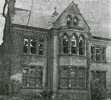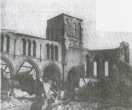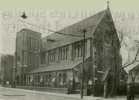For this church:    |
|
 Back
of the church Back
of the church(parish room, air-raid shelter to right), 1963 |
Further demolition was planned in the later 1930s but again a World War intervened. At St Philip’s three large community air raid shelters were built in the adjoining school playground. One was actually positioned against the wall of the south aisle. After the war they were all used for fuel storage, and survived until the church site was cleared in 1964.
Further slum clearance took place in the mid 1950s. Within a few years all the Victorian streets, alleys, yards and courts had been swept away by the bulldozer. Some of the cleared land was utilised for the construction of high-rise dwellings, but few of the new occupants found their way into the church congregation.
 The east end of the church The east end of the churchand surround area in the early 1960s |
 The vicarage just The vicarage justbefore demolition |
In 1960 the long serving Rev John Goulton (vicar 1914-60) died leaving the church without a vicar. In that same year the Bishop of Southwell proposed the closure of St Philip’s and the transfer of patronage to a new St Philip’s Church on the Bestwood Estate, to the north of the city. The vicarage in Sneinton was sold for £4,000 and demolished. A public house was built on the site. In 2009 after being closed for some time this was in turn sold and an Islamic Centre is planned to take its place.
St Philip’s did not disappear without a considerable effort to save it. The adjacent former recreation ground had already been purchased by the Boots Company and a new multi-storey research facility opened. Boots had also acquired most of the surrounding land for further development. An approach was made to the company suggesting that that it might like to retain the church. It was not to be. Boots did acquire the site and extended their research operation, but the small area once occupied by St Philip’s served only as a car park in 2009.
Following the Bishop’s announcement of closure the small congregation managed to keep it open until June 1963. A short report in the Nottingham Guardian of 19th January 1963 recorded a meeting attended by thirty members of the congregation, adding that they were mostly from outside the parish. This situation had existed at St Philip’s for many years. The minutes of the 1925 PCC meeting record not only the names of the eleven council members attending but also their addresses: none lived in the parish.
In 1929 only two out of fifteen PCC members were local residents, and again in 1950 none of the PCC members resided in the parish, and the population of the united parishes was only about 2,330 in 1951.
The church registers show that throughout this time the church was well used for marriages and funerals but somewhat less so for baptisms. The last Confirmation Service performed by the Bishop at St Philip’s was in the early 1950s.
Throughout its eighty-four years St Philip’s played a significant and active role in the community. Soon after the church was opened a two-storey school was built within the same site. Initially it accommodated over four hundred pupils aged five years to school-leaving age. With the introduction of the Hadow scheme, pupils were transferred to St Mary’s Secondary.
The social situation of the parishioners of the 1880s is evidenced by an entry in the parish magazine dated 1885, recording that every Tuesday and Friday “penny dinners were served”, the meal consisting of “soup, bread and a pudding”. The same magazine recorded twenty eight funeral services conducted in the church, of which fourteen were children under the age of ten years, nine of whom had not survived their first year. There were however eighty-one baptisms during the same period.
For the adults a Temperance Society was soon active, with regular twice-weekly meetings and parish outings to such places at Hardwick Hall (June 1885), although at six shillings per person it is questionable just how many of the parishioners could take part.
In 1954 just before the land clearance commenced the vicar listed some of the activities the church promoted: home visiting, young people’s social club, men’s institute, football and cricket clubs, open air preaching, meetings for women organised by the vicar’s wife and the Sunday School.
The vicar was also Chaplain to the Plumptre Hospital, located on the edge of the parish. Plumptre ‘Hospital’ was an almshouse for 13 elderly ladies. A regular Sunday afternoon service was originally held in the small chapel which had been dedicated in 1927, until a small building specifically designed as a chapel was erected in the garden during the 1950s. The Rev John Goulton always walked the parish, particularly from his vicarage to his church.
 The
demolition of The
demolition ofthe church in 1963 (Photo: Nottingham Guardian) |
On the closure of St Philip’s the vestments were presented to the Rev John Goulton’s son, and the organ was moved to Bramcote Parish Church. The parish was divided between St Christopher’s, Sneinton and St Catharine’s, St Ann’s Well Road, this latter being another church and parish carved out of St Mary’s.
Of the remaining church fittings, memorials, glass and fabric we have no trace. A newspaper photograph taken during the demolition suggests that the glass and everything else was simply destroyed.






